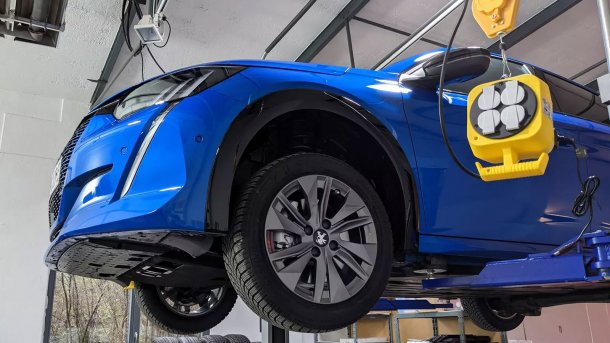Used electric cars: certificates for batteries are slow in coming
Only a few used electric cars have a battery certificate. This would have the potential to increase trust. How do the tests work?

A look under the car is always a good idea when buying a used car. With an electric car like this Peugeot e-208, assessing the condition of the battery is essential.
(Bild: Clemens Gleich)
- Christoph M. Schwarzer
Sales of used electric cars are currently slow. On the one hand, because prices are too high despite the discount campaigns for new cars and the domestic economy is weakening. Secondly, because there is a lack of confidence in the traction battery: anyone interested in a used electric car wants a reliable statement about the condition - SOH for State Of Health - of the electrochemical storage unit. Nobody wants an electric car that is already showing signs of a defect, even if the manufacturer still offers a warranty of several years. One way of substantially checking the SOH is through tests and certificates. But how do they actually work?
In principle, the conditions for buying a used electric car are ideal. The supply is large, which is partly a politically intended consequence of the so-called environmental bonus. Many modern electric cars such as the Hyundai Ioniq 5, VW ID.3 or Peugeot e-208 come onto the market as lease returns after a minimum holding period of two years. In plain language: the current situation is a buyer's market.
(Bild: Christoph M. Schwarzer)
Readout is not enough
Some sellers have no information about the SOH of the traction battery. Others only offer a readout of the BMS (battery management system). This data is not sufficient: after an examination of 1000 B MS by the diagnostics company Aviloo and comparison with the actual SOH, a deviation range of minus 38 to plus 91 percent was found. Although most of the values were approximately correct, in extreme cases a BMS displayed almost twice the actual value. A detailed test of the traction battery usually includes charging, discharging and recharging. Even non-experts can thus determine the energy content, although the unavoidable charging losses must be taken into account. These can vary considerably depending on the type of charging.
(Bild: Aviloo)
With Aviloo's premium test, a deviating internal resistance at cell level can also be detected using this method - albeit with a significantly more complex measurement and software background. The decisive factor here is the dynamic load in the measurement process. The customer then receives a detailed certificate with the actual energy content as a percentage of the new condition as well as a description of any defects at cell level and elsewhere. In this way, the Austrian company has collected well over 30,000 extensive data sets from a wide variety of electric cars and plug-in hybrids.
Comparison with databases
This collection forms the basis for the flash test. The flash test must meet the requirements of an expert who only has a few minutes to assess a lease return. He compares the data read from the BMS with that which Aviloo has obtained from the premium tests. This comparison allows a basic statement to be made about the functionality and reveals most faults.
(Bild: Aviloo)
However, unlike the Premium test, there is no indication of how many percentage points of the original range are still available. Instead, there is a score with a maximum of 100 points. Buyers who want ultimate certainty should ask the supplier whether they can do a premium test - perhaps even at their own expense - even if this adds several hundred kilometers to the speedometer.
Quick tests are important because the reality of the car trade does not allow for time-consuming detailed checks. Aviloo's most important competitor is also tailored to this requirement profile: Twaice's Battery Quick Check, which is offered in cooperation with TÜV Rheinland. In this case, the traction battery is not completely drained, but only tested in a stationary position for around an hour. Nevertheless, the quality of the Battery Quick Check is similar to that of Aviloo's premium test because it does not rely exclusively on BMS data and the manufacturer's algorithms, but uses simulation software. Twaice compares the data with a perfect traction battery in new condition, the so-called digital twin. The results are an SOH value and a possible fault analysis.
Certificates are still the exception
Comprehensive SOH testing of used electric cars is the most significant means of creating trust in the used market. But this development is still in its infancy, as a random sample of a search on mobile.de shows: 5.7 percent of all cars offered at the time of the search were electric cars. Of these 81,528 electric cars, only 1669 had an unspecified battery certificate. The spectrum ranges from high-quality tests to pure BMS readouts.
(Bild: Aviloo)
Commercial and the few private sellers obviously do not yet have the importance of a certified SOH test on their radar. Perhaps they do not know that this is even possible, or they refer to the manufacturer's warranty. Potential buyers should by no means be satisfied with this: There are good methods to test and identify SOH with some certainty. Retailers must learn to see these tests not as an annoying cost center, but as an opportunity to have satisfied buyers after the contract has been signed. This benefits both sides.
(are)